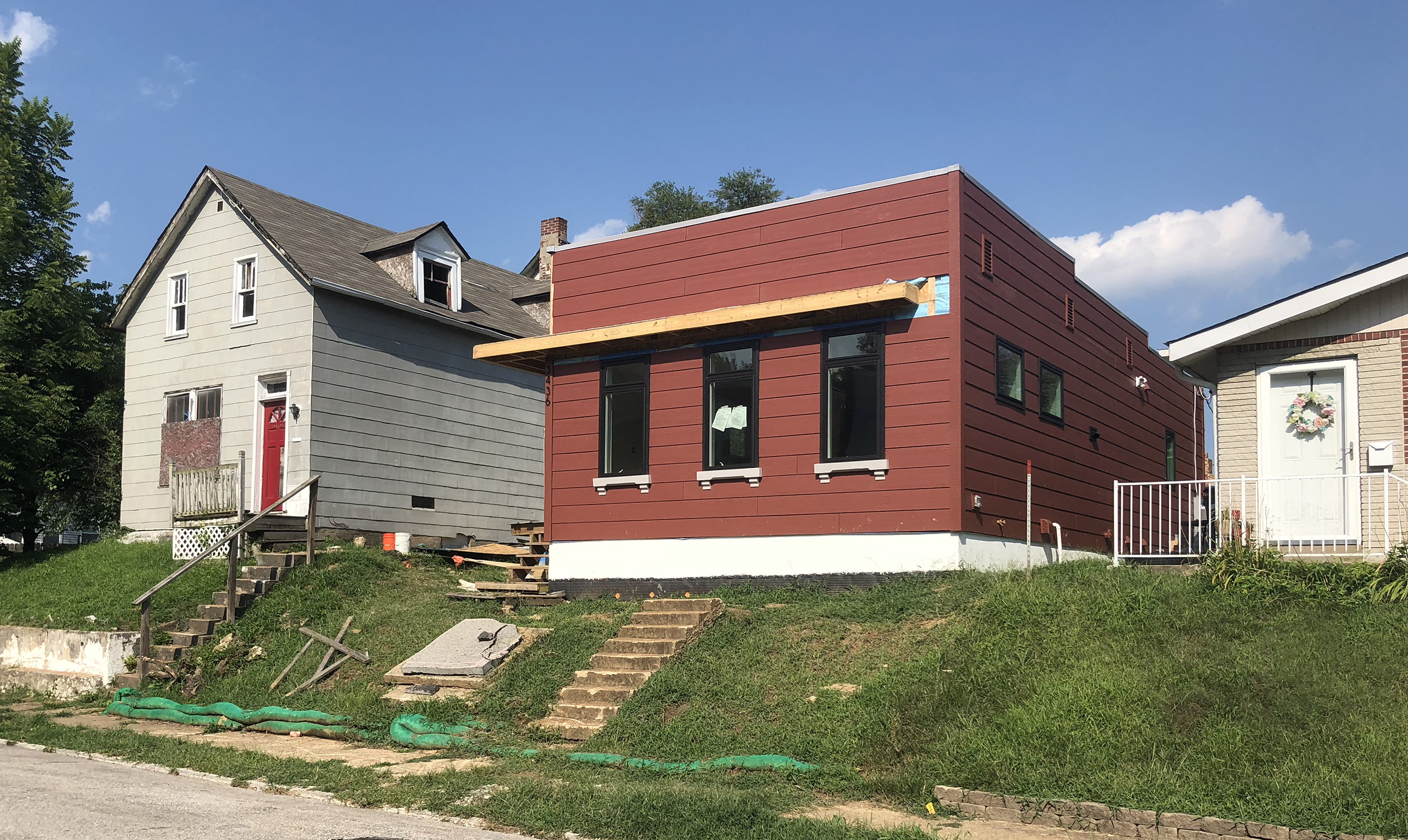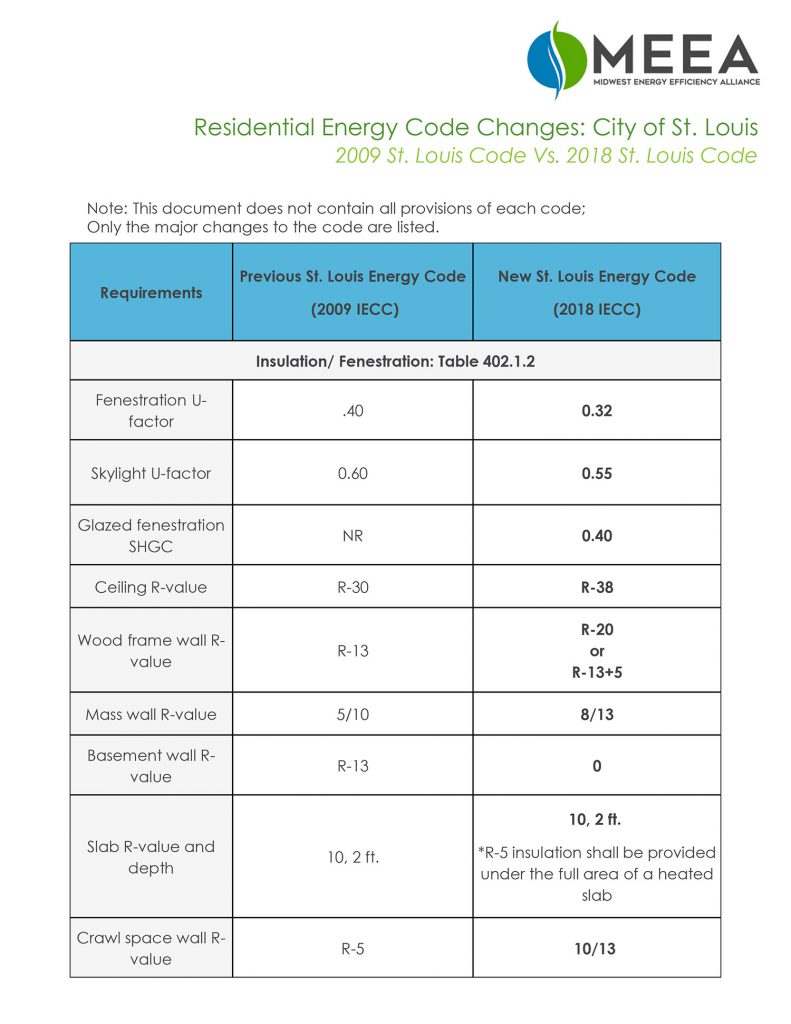On August 1st the City of St. Louis became the first municipality in the region – and one of the first nationwide – to adopt the 2018 suite of codes by the International Code Council (ICC). The new codes are a major upgrade from the 2009 codes previously being used in the city of St. Louis and significantly improve energy-efficiency requirements for new residential and commercial buildings as well as major renovations.
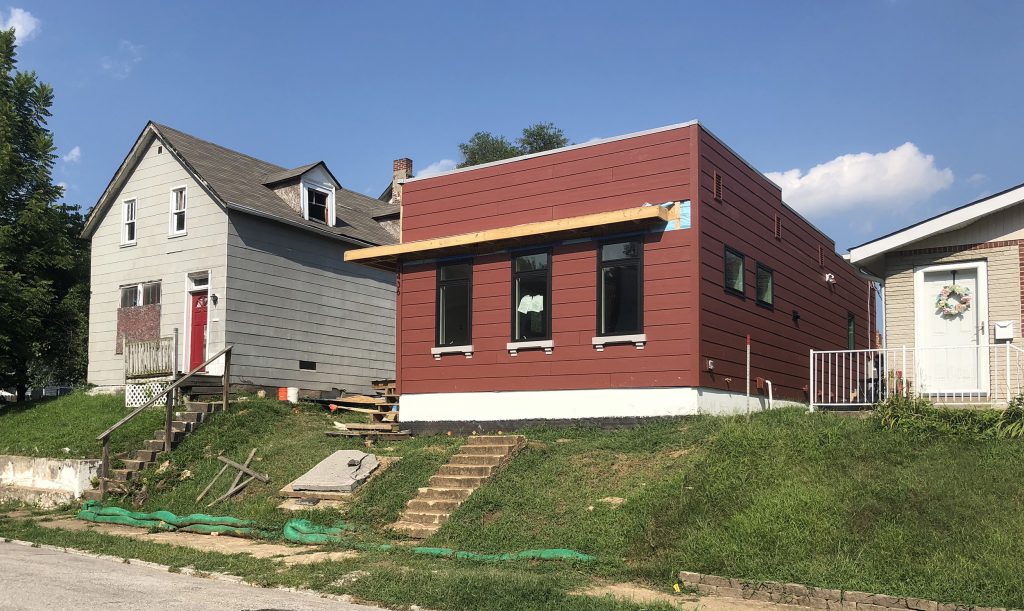
The city typically waits for St. Louis County to take the lead on code adoption, but this time the city decided to lead rather than follow, not only by becoming the first, but by introducing the 2018 Energy Conservation Code without major amendments. Previous versions of the city codes heavily amended the insulation and air-sealing requirements in the Energy Conservation Code. The adopted 2018 codes uphold the original code language for commercial insulation requirements. The residential insulation requirements include just two major amendments – the omission of basement insulation and reduction of ceiling/attic insulation from R-49 to R-38.
Amendments to the residential code were a compromise between the Missouri Sierra Club and the Home Builders Association of St. Louis and Eastern Missouri. Both organizations, along with members of The St. Louis Energy Coalition, provided input to the city’s Building Division and Public Safety Committee during the lengthy planning process.
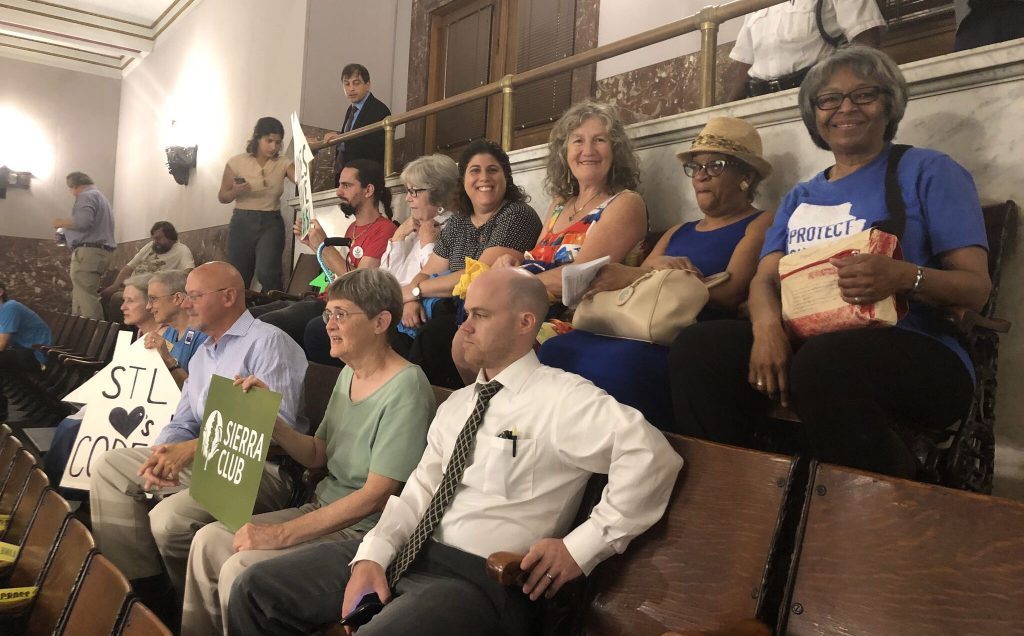
In addition to energy conservation, the 2018 Existing Building Code appears to introduce another major change from previous versions, in that more stringent compliance for electrical, mechanical and plumbing systems kick in at a lower threshold (Level 2 Alterations, rather than Level 3 alterations).
2018 Existing Building Code Levels of Alterations:
- Level 1 alterations include the removal and replacement or the covering of existing materials, elements, equipment, or fixtures using new materials, elements, equipment, or fixtures that serve the same purpose.
- Level 2 alterations include the reconfiguration of space, the addition or elimination of any door or window, the reconfiguration or extension of any system, or the installation of any additional equipment.
- Level 3 alterations apply where the work area exceeds 50 percent of the building area
Under the new 2018 codes, if electrical, mechanical or plumbing systems are modified or extended in existing buildings, it appears they will now be required to be brought up to standards similar to new construction instead of being “grandfathered in”. This has the potential to increase construction costs significantly for Level 2 alterations, especially for small businesses and commercial owner-occupants that typically do more piecemeal upgrades to save money instead of replacing entire systems all at once.
It is our understanding that the Existing Building Code section on Energy Conservation will remain in place, meaning full compliance with the new insulation and air-sealing requirements will be limited to Level 3 alterations, in which the work area exceeds 50 percent of the building area. A request for clarification from the Building Division is pending.
Level 2 alterations to existing buildings or structures are permitted without requiring the entire building or structure to comply with the energy requirements of the International Energy Conservation Code or International Residential Code. The alterations shall conform to the energy requirements of the International Energy Conservation Code or International Residential Code as the relate to new construction only (IEBC Section 810.1, unamended)
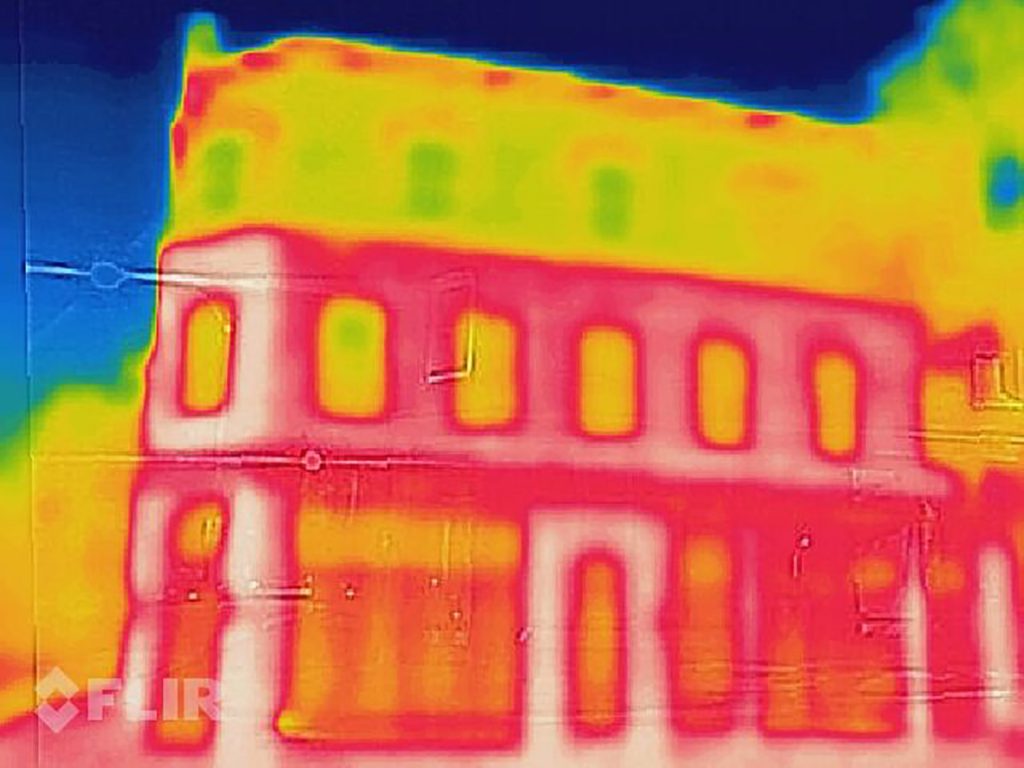
BENEFITS TO HOMEOWNERS
According to the St. Louis Energy Coalition & the Midwest Energy Efficiency Alliance, owners of new homes built to the 2018 codes, may reap the following benefits:
- Cost Savings & Efficiency: New homes will be on average 27% more energy efficient than those built under the 2009 code, which amounts to a $580 average annual energy savings and a reduced environmental footprint
- Comfort: More thermal insulation and better air-sealing mean cooler summers, warmer winters, fewer drafts and improved sound insulation
- Healthy Indoor Air Quality: Homes with proper insulation and air-sealing are healthier for people with asthma or other illnesses. The 2018 International Energy Code takes into account new research about the effects of buildings on our health.
- Stability: By keeping utility costs low, homeowners are able to maintain their homes longer and stay in place.
- Third Party Verification: A blower door test must be performed by an approved third party. In order to pass the test and receive a building permit, the measured air leakage must not exceed three air changes per hour.
KEY ENERGY EFFICIENCY CHANGES TO THE RESIDENTIAL CODE
St. Louis City MEEA comparison of residential 2009 code to 2018 code
KEY ENERGY EFFICIENCY CHANGES TO THE COMMERCIAL CODE
The Midwest Energy Efficiency Alliance cites several energy-efficiency related improvements in commercial buildings when comparing the previously amended 2009 code to the newly adopted 2018 IECC.
- Increased efficiency and resiliency of exterior building enclosure
- Increased insulation for slab floors, walls and roofs in most building types
- Increased efficiency of a mechanical equipment
- Most mechanical equipment must be rated to a higher efficiency
- Certain boilers required to comply with specific turndown ratio
- Economizers required on more cooling equipment – makes equipment operate more efficiently
- Energy recovery units required on certain sized ventilation systems
- Increased insulation on ductwork outside the conditioned space
- More efficient lighting and electrical outlets
- Occupant sensors required in most spaces
- Reduced energy use of installed lighting (indoors and outdoors) – Lower lighting power density required for most spaces
- Higher percentage of daylighting and controls required in most cases
- Automatic shutoff on electrical outlets when not in use to eliminate phantom load
- Added efficiency measures
- Minimum efficiency requirements for Refrigerators and walk-in coolers
- Minimum efficiency requirements for Fans
- Alternative compliance path for computer rooms
- Additional efficiency package – improves building efficiency by requiring a building comply with 1of 8 efficiency packages
- Building commissioning/system verification
- More robust system commissioning process
WHAT HASN’T CHANGED
The majority of the code will remain familiar to professionals accustomed to working with ICC codes. Likewise, many City of St. Louis amendments will carry over to the new codes. One such amendment waives the requirement for the installation of automatic fire sprinkler systems in townhouses, single-family homes, or multi-unit dwellings of four or fewer units. As before, the builder of any such residences is required to offer buyers the option to install or equip fire sprinklers in the dwelling, residence or unit – though in practice, few seem to be aware of this longstanding St. Louis requirement. (2018 International Residential Code Sections R313.1 through R313.2.1)
The permitting fee structure remains unchanged.
The Uniform Plumbing Code 2009 (UPC) remains in effect and the newly adopted ICC ordinances have been revised as required to reference this code and its publisher.
TIMELINE
Enforcement of the new codes is in effect, as of August 1, 2018 for new building permit applications. Projects already under construction or actively coordinating with the Building Division will not be required to comply retroactively.
RESOURCES
A copy of each of the new codes will be kept on file in the Office of the Register of the City of Saint Louis. Digital copies (without local amendments) may be viewed online via the ICC’s Public Access.
Local amendments to the original documents are currently available under their respective Board Bills (https://www.stlouis-mo.gov/government/city-laws/board-bills/index.cfm) and will eventually be accessible within the city code, “Title 25 – Buildings and Construction” (https://www.stlouis-mo.gov/government/city-laws/code/index.cfm) or (https://www.municode.com)
FULL SUITE OF ADOPTED CODES
- 2018 International Building Code (Board Bill 53 / Ordinance 70794)
- 2018 International Energy Conservation Code (Board Bill 58 / Ordinance 70799)
- 2018 International Existing Building Code (Board Bill 56 / Ordinance 70797)
- 2018 International Residential Code (Board Bill 54 / Ordinance 70795)
- 2018 International Mechanical Code (Board Bill 59 / Ordinance 70800)
- 2018 International Property Maintenance Code (Board Bill 57 / Ordinance 70798)
- 2018 International Fuel Gas Code (Board Bill 60 / Ordinance 70801)
- 2018 International Fire Code (Board Bill 55 / Ordinance 70796)
- 2017 National Electrical Code (Board Bill 61 / Ordinance 70802) *
* National Electrical Code published by the National Fire Protection Association, Inc
OVERVIEW OF KEY CODE CHANGES
BUILDING CODE (IBC)
- Revised to allow a single hearing on multiple buildings with the same issues by the same owner before the Board of Building Appeals (IBC Section 113.5.2)
- Now allows legally-occupied parking lots to restripe without needing a permit
- Fence heights restricted to 10 feet in commercial districts
- Language on guard rails restored to original 2018 code
- Incidental Occupancies Table does not appear in the 2018 code (previously appeared as 2009 Table 508.2.5)
- Accessory Storage Spaces Regardless of size, storage rooms and spaces that are accessory to other uses are to be classified as part of the occupancy to which they are accessory. (IBC Section 311.1.1)
RESIDENTIAL CODE (IRC)
- New Section R106 “Floor and Roof Design Loads” added to conform with IRC book
- Language on treads and risers revised to reflect 2018 language. Prior amendments are carried over, allowing for a max riser height of 8 ¼ inches and a minimum tread depth of 9 inches.
- Language on guard rails restored to original 2018 code. Prior amendment outlawing ornamental guard rails with “ladder effect” has been removed.
- New Sections R328 “Modular Units” and Section R329 “Tiny Houses” added
- The requirement for one habitable room with a minimum floor area of 120 square feet has been removed in the 2018 IRC.
- Glazing Adjacent to Doors Glazing within 24 inches of the hinge side of an in-swinging door now requires safety glazing where the glazing is at an angle less than 180 degrees from the plane of the door. (R308.4.2)
- Alternating Tread Devices and Ships Ladders Alternating tread devices and ships ladders are now permitted as a means of egress for lofts with an area that does not exceed 200 square feet (R311.7.11 and R311.7.12)
- Window fall protection shall be provided in dwelling units, where the top of the sill of an operable window opening is located less than 24 inches above the finished floor and greater than 72 inches above the finished grade (R312.2.1 and R312.2.2)
- Interconnection of Carbon Monoxide Alarms is now required where multiple carbon monoxide alarms are required in a dwelling unit. (R315)
- The required percentage of permanent lighting fixtures having high-efficacy lamps has increased to 90 percent. (R404.1)
- The building or dwelling unit shall be tested as having an air leakage rate not exceeding three air changes per hour. Testing shall be conducted in accordance with RESNET/ICC 380, ASTM E779 or ASTM E1827 and reported at a pressure of 0.2 inches w.g. (50 Pascals). (N1102.4.1.2 / R1102.4.1.2)
EXISTING BUILDING CODE (IEBC)
- Added exceptions allowing Live/work units and Owner-occupied lodging houses with five or fewer guest rooms to be built in accordance with the Residential Code for One- and Two-family Dwellings. (IEBC 101.2)
- Added adoption of APPENDIX C: Guidelines for the Wind Retrofit of Existing-Buildings
- New Section 121 “Registration of Vacant Buildings” requires owners of vacant residential or commercial structures with code violations to pay a semiannual fee of $200
- Added sections clarifying that unresolved design issues related to accessibility be resolved in coordination with the City of St. Louis Commissioner on the Disabled (IEBC 301.5, 305.4, 305.8.7 and 305.9)
- Sections dealing with Mechanical, Electrical and Plumbing renumbered to 809-811 and referred to appropriate local code.
FIRE CODE (IFC)
- Sections added for Mobile food preparation vehicles (105.6.30), Mobile fuel dispensing facilities (105.6.31), Outdoor assembly event (105.6.36) and Plant extraction systems (105.6.38)
- Section 401.9 added to allow Fire Dept to require a fire watch if necessary
- Sections 907.6.6 and 907.8.5 changed to reflect monitoring and maintenance of fire safety systems
- Section 918.8 requires semi-annual testing of duct and hood extinguishing systems
PROPERTY MAINTENANCE (IPMC)
- Legal Defense section added to give same protection as in Building Code for actions under the Property Maintenance Code (104.8.1)
- The requirements for handrails have been restored to original 2018 code language
- Section 508 added to cover plumbing repairs
- Hotels now referred to as “Special Residential Uses”
PROPERTY MAINTENANCE (IPMC)
- Legal Defense section added to give same protection as in Building Code for actions under the Property Maintenance Code (104.8.1)
- The requirements for handrails have been restored to original 2018 code language
- Section 508 added to cover plumbing repairs
- Hotels now referred to as “Special Residential Uses”
MECHANICAL (IMC)
- Severability clause added (101.4)
- Mechanical permit applications made now be made online (106.3)
- Section 107.1 allows the code official to conduct inspections as necessary
- Section 107.2 further defines the required inspections
- Section 110 added for Temporary Equipment, Systems and Uses
- Commercial kitchen exhaust hood requirements modified (507.1, 507.2 & 603)
FUEL GAS (IFGC)
- No major changes
- Extraneous definitions removed
ENERGY CONSERVATION (IECC)
- No major changes
- Climate Table revised with updated local climactic data
ELECTRICAL (NEC/NFPA 70)
- No major changes
- Certificate for Limited Liability Insurance of $1,000,000 required
Editors Note: This list is intended to provide an overview of major changes. It is not comprehensive, may contain errors, and is not to be used in place of referencing the actual codes linked above. For questions contact the Building Division or consult a licensed architect or engineer.
